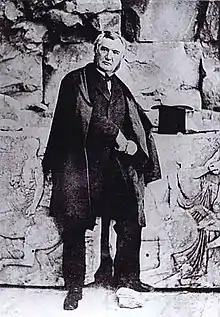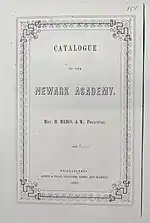Matthew Meigs
Matthew Kugler Meigs (February 5, 1812 – October 9, 1889) was an American educator, scholar, and Presbyterian clergyman. Although best known as the founder and principal (headmaster) of The Hill School in Pottstown, Pennsylvania, Meigs also served a short term as U.S. Consul to Piraeus, Greece, pastored churches, and preceded his time at The Hill School with teaching posts at a variety of other secondary and university level institutions including a short term as President of Delaware College (subsequently the University of Delaware).
The Reverend Dr. Matthew Meigs | |
|---|---|
 | |
| Born | Matthew Kugler (Kughler) Meigs February 5, 1812 |
| Died | October 9, 1889 (aged 77) |
| Resting place | Edgewood Cemetery, Pottstown, Pennsylvania |
| Alma mater | |
| Occupations |
|
| Known for |
|
| Spouse | Mary Ripley Moulton Gould |
| Children | Eleven |
| Parents |
|
Life
Meigs was born in Albany, New York, on February 5, 1812. He was the son of Major John Meigs and grandson of Seth Meigs, a Revolutionary War soldier.[1] He married Mary Gould on April 11, 1842.[2] Eleven children were born to them between 1844 and 1858. Son John succeeded his father as The Hill School's headmaster, serving in that position from 1876 to 1911.[1]: 78, 118

Academic studies and early career
Meigs received his undergraduate degree in languages and linguistics from Union College (1836) and theological training from Union Theological Seminary (1839) after which he was ordained a Presbyterian Minister.[2] Other degrees followed including a Ph.D. from Lafayette College.[3] Various alumni journals, histories and obituaries concur that he was at some point also awarded the degrees of D.D. (Doctor of Divinity) and L.L.D. (Doctor of Laws).[4][5][6] Union College specifically attributes the L.L.D. to Lafayette College in 1868.[7]
Meigs early academic career included posts at schools in South Carolina, Winchester, Virginia, and the University of Michigan. He then became a teacher and principal of Newark Academy (1846-1851) before becoming president of Delaware College (1850-1851). During his time in Michigan, he also pastored a church in Pontiac.[2]
The Hill School and later career
Meigs' most notable legacy is in the founding of The Hill School in 1851 in Pottstown, Pennsylvania from which he retired as principal in 1876.[1]: 245 During his tenure at The Hill, he took a brief leave of absence from 1868-1869 to serve as U.S. Consul to Piraeus, Greece.[8]
Meigs continued his interest in the church even after education became his primary professional focus. He and his family were active at the First Presbyterian Church in Pottstown.[9][10] His obituaries attest to the respect accorded both his clerical standing in the church and his status as a scholar by describing him as a "well-known Presbyterian divine" and a "distinguished scholar and clergyman...a man of fine literary attainments, distinguished as a philologist" at the time of his death.[6][11]
Death
Meigs died on October 9, 1889, in Clifton Springs, New York, and was buried in Edgewood Cemetery in Pottstown. The New York State death certificate (#36123) and local obituaries agree on October 9 as his death date.[6][11] However, the Journal of the Presbyterian Historical Society, The University of Delaware Archives, and The Union Theological Seminary Alumni Catalog give October 10 as date of death.[12][2][13]
References
- Henry Benjamin Meigs (1901). Record of the Descendants of Vincent Meigs: Who Came from Dorsetchire, England, to America about 1635... J. S. Bridges & Company. pp. 30, 46, 78.
- "Information on Matthew Kughler Meigs". University of Delaware Archives (Information Sheet 12).
- Selden Jennings Coffin (1891). The Men of Lafayette, 1826-1893: Lafayette College, Its History, Its Men, Their Record. G.W. West. p. 189.
- Theodore Weber Bean (1884). History of Montgomery County, Pennsylvania. Unigraphic. p. 420.
- Phi Beta Kappa. Alpha of New York (Union College) (1922). Centennial Catalog: New York Alpha of the Phi Beta Kappa, Union College. p. 31.
- "Death of Rev. Matthew Meigs". The Times (Philadelphia, Pennsylvania). October 10, 1889. p. 1. Retrieved 19 February 2018 – via Newspapers.com.

- Andrew Van Vranken Raymond (1907). Union University: Its History, Influence, Characteristics and Equipment, with the Lives and Works of Its Founders, Benefactors, Officers, Regents, Faculty, and the Achievements of Its Alumni. Union College, Albany Medical College, Albany Law School, Dudley Observatory, Albany College of Pharmacy. Lewis Publishing Company. p. 81.
- "Confirmations". National Republican(Washington, District of Columbia). July 27, 1868. p. 2. Retrieved 27 February 2018 – via Newspapers.com.

- Chancellor, Paul (1953). A History of Pottstown, Pennsylvania 1752-1952. Historical Society of Pottstown, Pennsylvania. p. 57.
- "History". First Presbyterian Church, Pottstown, PA. Retrieved 27 February 2018.
- "Matthew MeigsObituary". Daily Times and Dispatch (Reading, Pennsylvania). October 11, 1889. p. 4. Retrieved 27 February 2018 – via Newspapers.com.

- ^ Presbyterian Historical Society (1920). Journal - Presbyterian Historical Society. Volume X. Department of History of the United Presbyterian Church in the U.S.A. p. 199. Retrieved 27 February 2018.
- Union Theological Seminary Alumni Catalog 1836-1936. 1937. Retrieved 17 October 2017.
Further reading
- Munroe, John (1986). The University of Delaware: A History. University of Delaware.
- Chancellor, Paul (1976). The History of The Hill School 1851-1976. The Hill School.